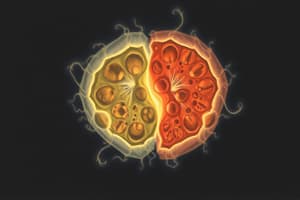Podcast
Questions and Answers
What cellular structures form during telophase to help in separating the daughter cells?
What cellular structures form during telophase to help in separating the daughter cells?
- Actin and myosin (correct)
- Spindle fibers
- Kinetochore fibers
- Centrioles
What is the primary function of cyclins in the cell cycle?
What is the primary function of cyclins in the cell cycle?
- To regulate the progression of the cell cycle (correct)
- To aid in cytokinesis
- To check the cell's environment
- To repair DNA damage
What is the role of the G2 checkpoint in the cell cycle?
What is the role of the G2 checkpoint in the cell cycle?
- To check the overall cell size
- To ensure DNA replication is complete (correct)
- To confirm spindle fibers are attached
- To prepare the cell for anaphase
During which phase do chromosomes reappear as uncondensed chromatin?
During which phase do chromosomes reappear as uncondensed chromatin?
What initiates the cleavage furrow during cytokinesis in animal cells?
What initiates the cleavage furrow during cytokinesis in animal cells?
What happens if a cell loses control of its cell cycle?
What happens if a cell loses control of its cell cycle?
Which phase of the cell cycle is primarily concerned with the alignment of chromosomes at the cell equator?
Which phase of the cell cycle is primarily concerned with the alignment of chromosomes at the cell equator?
What occurs to the nuclear envelope during telophase?
What occurs to the nuclear envelope during telophase?
Which checkpoint ensures the spindle fibers are properly attached to chromosomes?
Which checkpoint ensures the spindle fibers are properly attached to chromosomes?
What is the role of cyclin-dependent kinases (CDKs) in the cell cycle?
What is the role of cyclin-dependent kinases (CDKs) in the cell cycle?
What is the primary purpose of cell division in organisms?
What is the primary purpose of cell division in organisms?
During which phase of the cell cycle does DNA replication occur?
During which phase of the cell cycle does DNA replication occur?
Which of the following stages is NOT a part of mitosis?
Which of the following stages is NOT a part of mitosis?
What occurs during binary fission in prokaryotes?
What occurs during binary fission in prokaryotes?
Which type of reproduction produces new cells that are identical to the parent cells?
Which type of reproduction produces new cells that are identical to the parent cells?
What describes the outcome of sexual reproduction?
What describes the outcome of sexual reproduction?
What role does the p53 protein play in the cell cycle?
What role does the p53 protein play in the cell cycle?
What may occur as a result of mutations in DNA during the cell cycle?
What may occur as a result of mutations in DNA during the cell cycle?
Which of the following best characterizes necrosis?
Which of the following best characterizes necrosis?
How does a cancer cell with a defective p53 gene behave compared to a normal cell?
How does a cancer cell with a defective p53 gene behave compared to a normal cell?
What is the main consequence of losing control over the cell cycle?
What is the main consequence of losing control over the cell cycle?
In the context of cancer, what is the significance of the G1/S checkpoint?
In the context of cancer, what is the significance of the G1/S checkpoint?
What is the primary purpose of the G1 phase in the cell cycle?
What is the primary purpose of the G1 phase in the cell cycle?
Which phase follows the S phase in the cell cycle?
Which phase follows the S phase in the cell cycle?
What happens during the anaphase of mitosis?
What happens during the anaphase of mitosis?
Which of the following statements is true regarding mitosis?
Which of the following statements is true regarding mitosis?
What occurs during the G2 phase of the cell cycle?
What occurs during the G2 phase of the cell cycle?
Which of the following types of cells typically do not undergo mitosis?
Which of the following types of cells typically do not undergo mitosis?
What is the overall outcome of the cell cycle?
What is the overall outcome of the cell cycle?
What is the correct sequence of phases during mitosis?
What is the correct sequence of phases during mitosis?
Flashcards are hidden until you start studying
Study Notes
Introduction
- Organisms need new cells for growth, replacement of damaged or lost cells
- New cells are derived from ancestor cells
- New cells are produced by asexual and sexual reproduction
Cell division
- Prokaryotes
- Single circular DNA molecule
- Replicated DNA is attached to cell membrane
- Cell pulls apart, separating DNA
- Two identical daughter cells are formed
- Eukaryotes
- Division initiated when cell has reached appropriate size and has enough protein and energy stores.
Cell cycle
- Represents stages from when a cell divides into two daughter cells until those daughter cells divide again.
- Divided into three phases:
- G1: primary growth phase
- S: DNA replication occurs
- G2: secondary growth phase
- G1, S, and G2 are collectively called interphase
- Mitosis: Nuclear division
- Cytokinesis: Division of cytoplasm
Interphase
- G1 phase:
- Cell grows
- Increases supply of proteins needed for division
- Increases number of organelles like mitochondria
- Protein synthesis occurs
- S phase:
- DNA quantity is doubled
- Chromosomes replicated into two sister chromatids
- G2 phase:
- Second growth phase after DNA duplication
- Cell synthesizes structures needed for division
- Completed interphase results in a cell that can start mitosis
Mitosis
- Occurs only in eukaryotes
- Some cells do not undergo mitosis, like nerve and brain cells
- Divided into four phases:
- Prophase: Chromatin condenses into chromosomes, nucleolus and nuclear membrane disappear, mitotic spindle forms
- Metaphase: Chromosomes attach to kinetochore fibers and line along cell equator
- Anaphase: Spindle fibers pull sister chromatids apart; each pole of the cell has a complete set of original genes
- Telophase: Chromosomes reappear as chromatin, nuclear envelope starts to form, nucleolus is visible, spindle breaks apart
Cytokinesis
- Physical process of cell division
- Divides cytoplasm into two daughter cells
- Actin and myosin contractile ring forms a cleavage furrow, separating the cytoplasm
Regulation of cell cycle
- Aims to control cell division to prevent uncontrolled cell growth
- Regulatory molecules involved: cyclins and cyclin-dependent kinases (CDK)
- Cyclin and CDK form a heterodimer, phosphorylating and activating or deactivating target proteins
- Checkpoints: Monitor and regulate the progress of the cell cycle, allowing for verification of necessary phase processes and repair of DNA damage
- G1 checkpoint: Ensures everything is ready for DNA replication.
- G2 checkpoint: Ensures the cell is ready for mitosis.
- Metaphase checkpoint: Ensures the cell is ready to complete cell division.
Uncontrolled cell division
- Uncontrolled cell cycle results in tumor formation
- Damaged/defective p53 gene causes loss of information needed to respond to control signals
- Cancer cells with defective p53 cannot respond to cell cycle controlling signals, leading to uncontrolled division
Normal cell versus cancer cell
- Normal cell:
- DNA replicated properly
- Chemical signals start and stop cell cycle
- Cells communicate with each other to avoid overcrowding
- Cancer cell:
- DNA mutations occur during replication
- Chemical signals that control the cell cycle are ignored
- Cells do not communicate with each other leading to tumor formation
Cancer
- Failure of cell division control leading to uncontrolled tissue growth
- P53 gene plays key role in G1/S checkpoint, halting cell division if damaged DNA is detected
- All cancer cells have to shut down p53 activity
Cell death
- Necrosis:
- Unregulated cell death
- Death of most or all cells in an organ or tissue due to disease, injury, or lack of blood supply
- Apoptosis:
- Regulated cell death
- Energy-dependent programmed cell death for removing unwanted individual cells
Necrosis vs. Apoptosis
- Necrosis: Unregulated, accidental cell death often causing inflammation and damage.
- Apoptosis: Regulated, controlled cell death important for development, tissue remodeling, and removal of dysfunctional cells.
Apoptosis in physiologic situations
- In the human body, about 100,000 cells are produced every second by mitosis and a similar number die by apoptosis.
- Embryogenesis:
- Morphogenesis, removal of excess cells between fingers and toes
- Metamorphosis of a tadpole into a frog
- Adults:
- Tissue remodeling, removal of cells no longer needed
- Virgin mammary gland, Late pregnancy, lactation, Involution
- Prostate gland: Apoptosis regulated by testosterone
Apoptosis in disease
- Too Much: Tissue atrophy, neurodegeneration, thin skin
- Too Little: Hyperplasia, atherosclerosis
Question
- Cells divide rather than simply increase in size, as it maintains cellular function by addressing issues like:
- Surface area to volume ratio: As cells enlarge, surface area to volume ratio decreases, limiting nutrient uptake and waste removal. Division maintains a favorable ratio for efficient functions.
- Complexity of cell processes: Division ensures each daughter cell receives a full set of genetic material and organelles, enabling specific functions to be performed efficiently. Enlarging a cell would strain its ability to perform complex tasks effectively.
- Replication and repair: Division allows for replication of genetic material and organelles ensuring the correct functioning of new cells. It also allows for repair mechanisms to be distributed across daughter cells, helping to maintain the integrity of tissues.
Studying That Suits You
Use AI to generate personalized quizzes and flashcards to suit your learning preferences.




